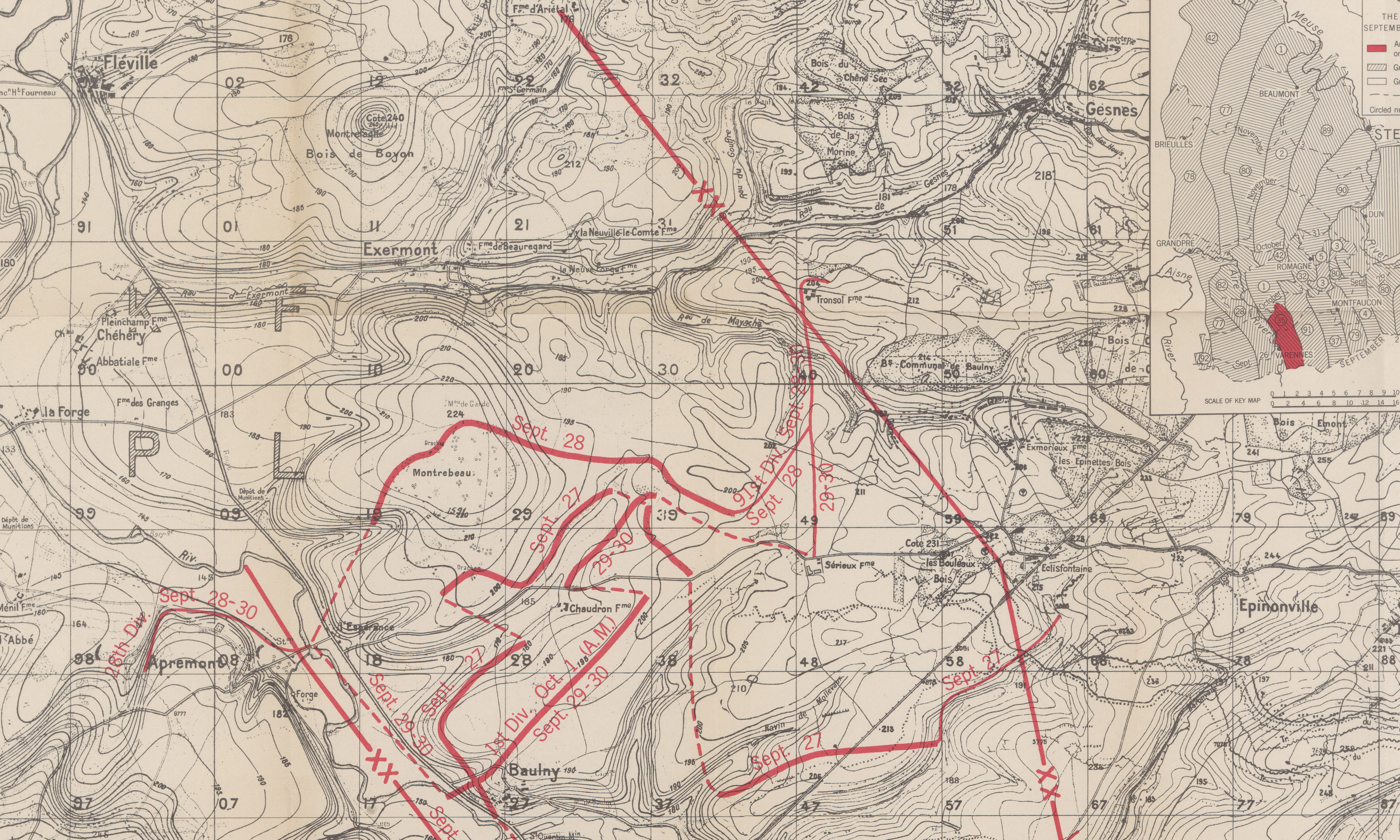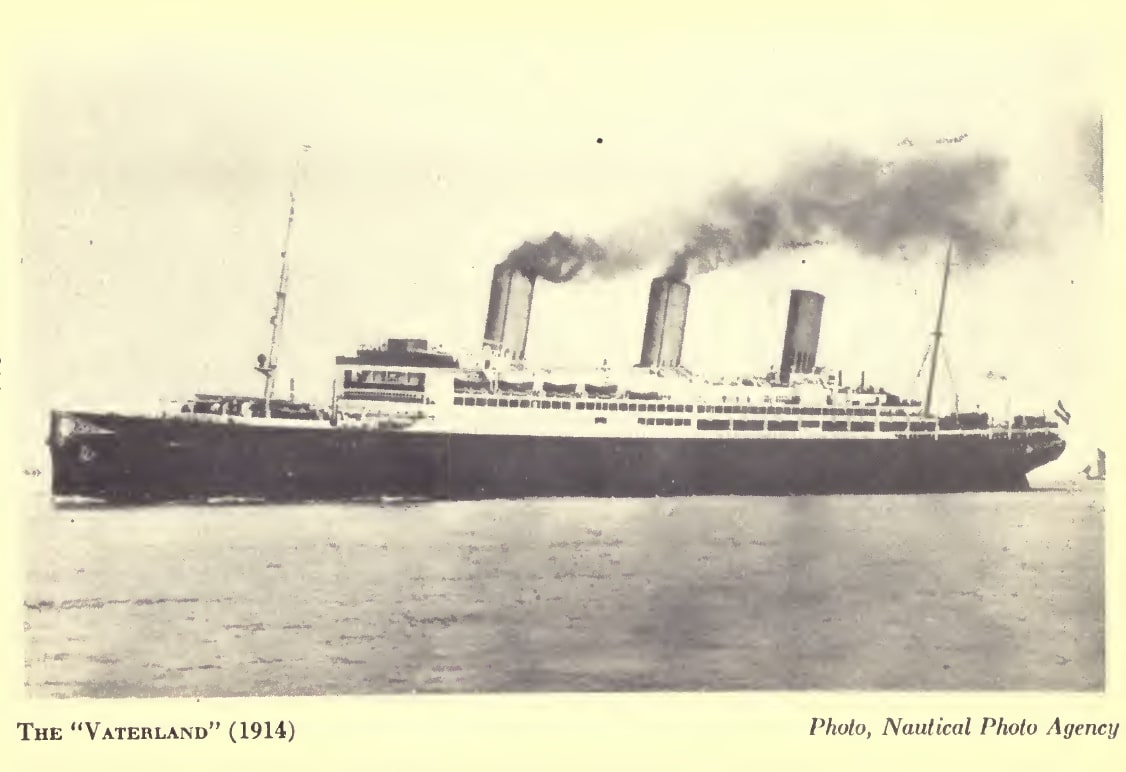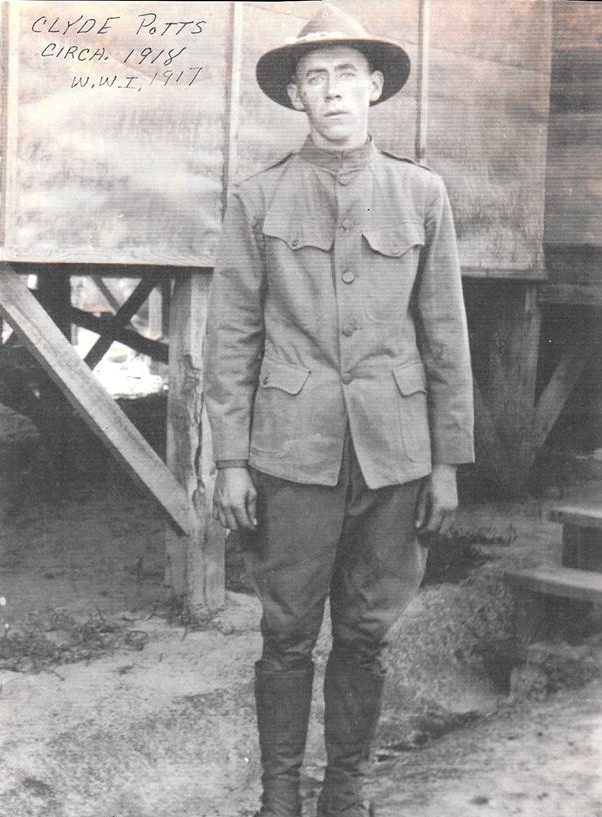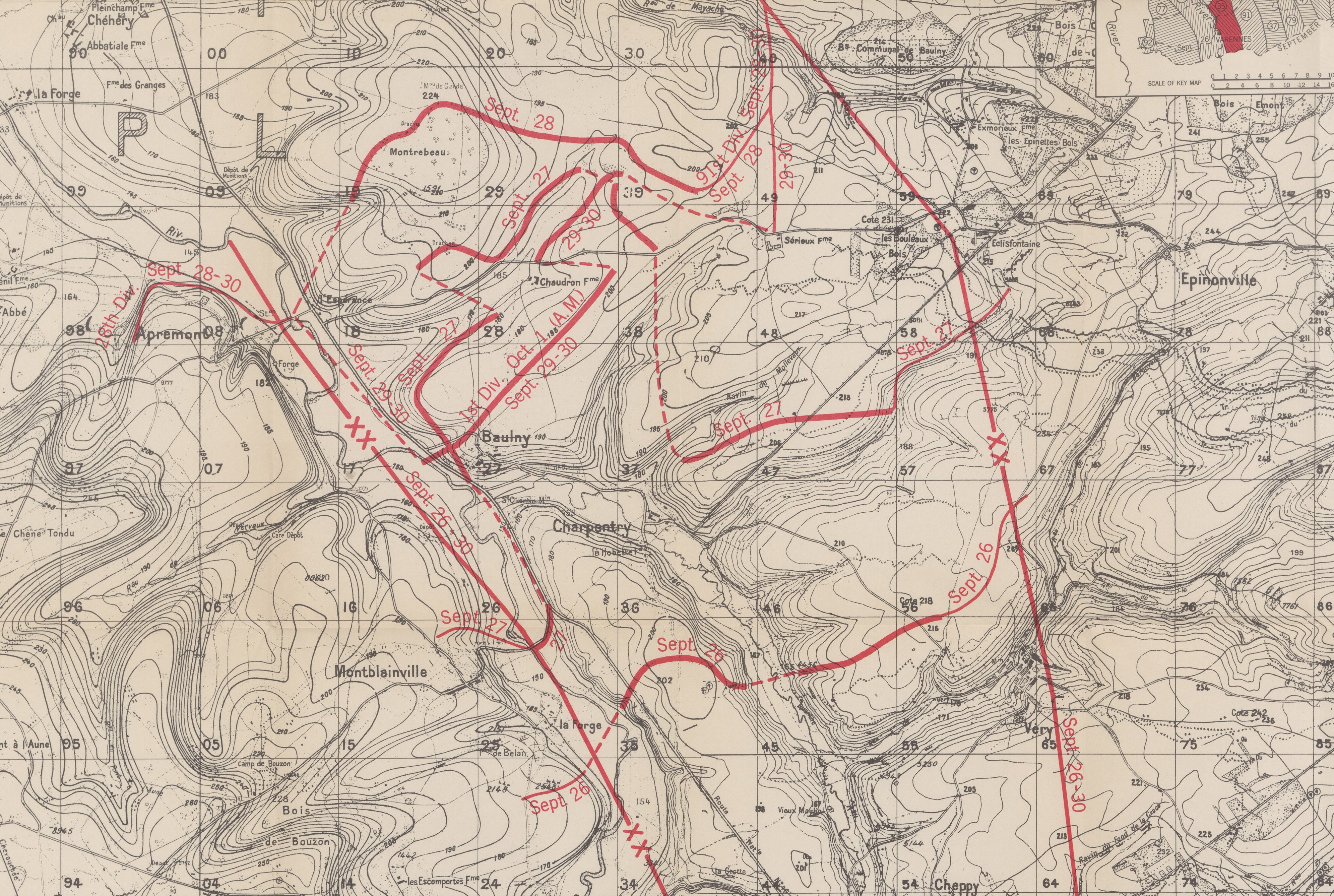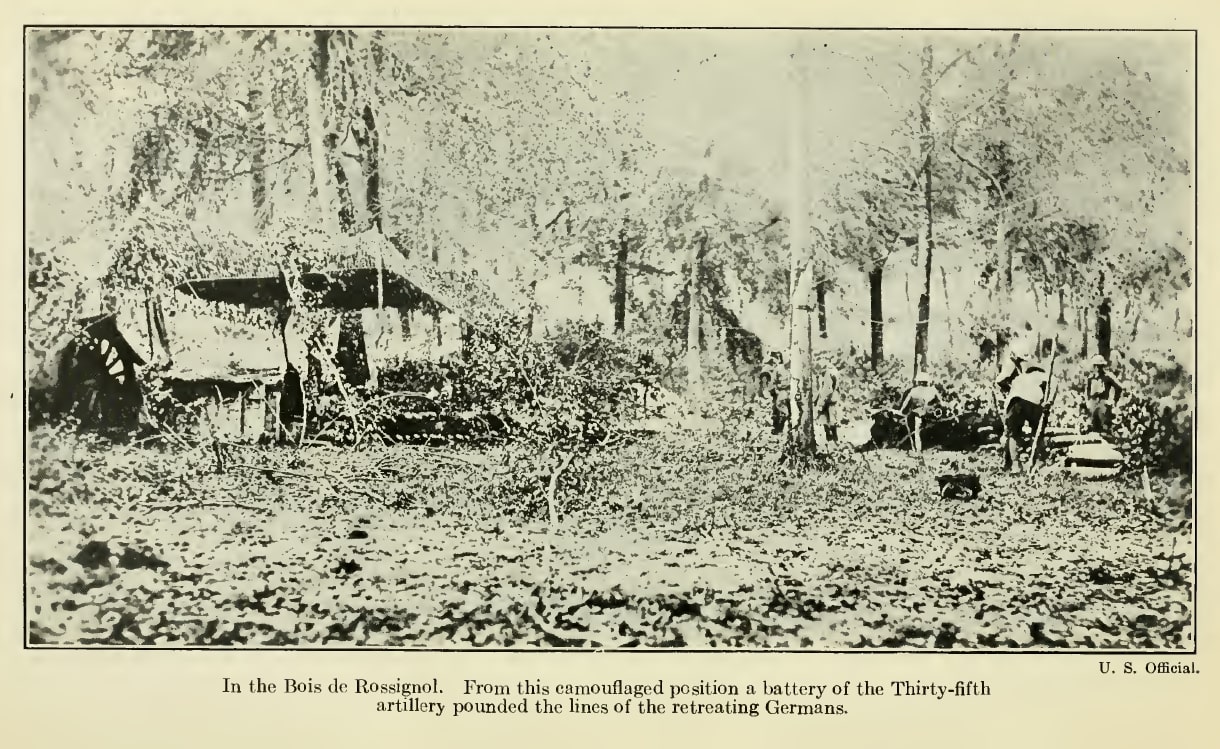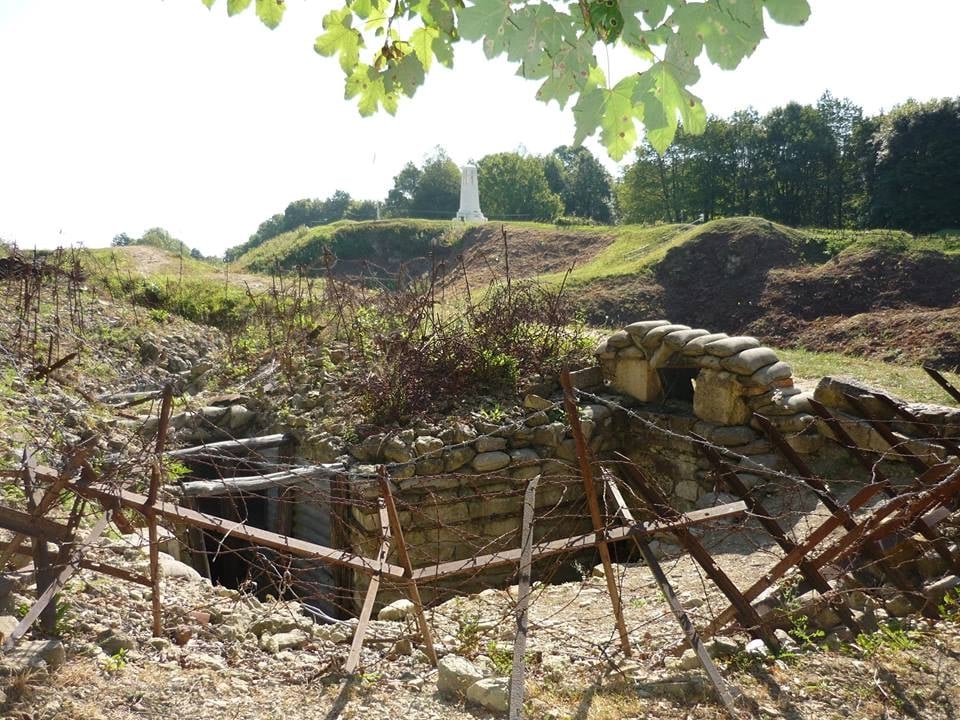Relieved
At 3 a.m., October 1, the 35th Infantry was the fourth of Pershing’s nine front-line divisions to be relieved from the front.
The troops of the 1st Infantry Division, in country since June, 1917, were veterans of the Battles of Cantigny, Soissons, and Saint-Mihiel. When they pressed the attack four days later, they fought for eight days to reach the other side of Fléville, two kilometers northwest of Exermont.
Meanwhile, the battle-weary 35th filed back to Cheppy. From there, they marched south then east, to Vavincourt, where they rested from October 6 to 11.
“The days [at Vavincourt] were not without their drills, their policing, and all that is a part of the camp routine. The soldier had heard much of the rest camps, where men wined and dined after they had suffered heavy fighting.
“The rest camp, it was found, was another army chimera. Reveille, retreat, drill, and a repetition of all those things they had done over and over again for nearly a year and a half, was what greeted them daily. Vin rouge and bad beer they had, if that would be called wining; bully-beef and beans they had, if that could be called dining. The rest camp made the soldier long for the battle.” (Hoyt 123)
Rested and reequipped, the 35th marched again east to take over the Sommedieue sector, a quiet stretch of front south of Verdun. There, it relieved a French division in the trenches October 14. The division’s next move would be November 1.
“In the Sommedieue sector, there was little doing, although it was, generally speaking, much livelier than the old days in the Vosges. All four regiments were in the line, each having two battalions in the line and one in support.” (Kenamore 246)
“It was while on this sector the first seven-days furloughs were granted to the men. Grenoble, yet uninvaded by Americans, was the first furlough area thrown open to the Thirty-fifth or other organizations of the A. E. F. The French met the train at the depot with flags, bands and cheers. Pretty girls blew kisses from their finger tips and old women waved and wiped away the tears. There were twelve hundred men of the division who tasted again of the sweetmeats of civilization. They were given good rooms in good hotels, good meals at the best eating houses, and with no cost to themselves. They answered to no call except their own whims, went where they pleased in the city, and were treated as guests.” (Hoyt 127)
These “seven-days furloughs” are important for Grandpa’s two final war stories, coming up in October. If the men are getting leave to go to a city 550 km (340 mi.) distant, the officers are as well. When a commanding officer is off-duty, remaining officers rotate through the position of “duty officer” to handle day-to-day responsibilities.
My great grandfather, like many veterans, didn’t talk much about his wartime experience. His family has only his discharge paper and a few anecdotes.
One hundred years later, I’ve discovered a few documents that bear his name. From draft registration to discharge, I’m following the paper trail of B. F. Potts’s journey to the battlefields of the Great War in France and back home again.
Previous articles:
“Well, Daddy, what did you think about France?”
“It’s a very muddy place.”
Benjamin Franklin Potts Registers for the Draft
As the Great War thundered across the fields of northern France, ten million American men, ages 21 to 30, signed their names to register to be drafted into military service.
Military Induction and Entrainment
“I, Benjamin Franklin Potts, do solemnly swear to bear true allegiance to the United States of America, and to serve them honestly and faithfully, against all their enemies or opposers whatsoever…”
“If it moves, salute it. If it doesn’t move, paint it!”
Embarkation, the Tunisian, and the Bridge of Ships
In his first ocean voyage, B. F. Potts crossed the submarine invested waters of the North Atlantic in a convoy of steamers escorted by a warship.
Enterprise, Tennessee: The Town That Died
Grandpa owned matched pairs of horses. Him and the boys [Ben and his brothers] cut and snaked logs out of the wood to the roads. He got a dollar a day plus fifty cents for the horses.
Rendezvous with the 35th Infantry Division
“Some of the guys disobeyed orders, went into the town, broke into a bakery, and stole all the bread and baked goods…”
The battle of Saint-Mihiel (September 12-15) would be Pershing’s first operation as army commander. He assigned the 35th to the strategic reserve, whose purpose is to replace a weakened unit or to fill any gap in the line created by the enemy.
“Private Potts, how tall are you?”
The soldier, looking into a button of the captain’s coat, says, “Five foot three, sir.” The wide brim raises.
On the front now, the 35th was in range of artillery fire, and enemy planes made nighttime bombing raids over the countryside.
Planning the Meuse-Argonne Offensive
On the left, the 137th would take the “V of Vauquois,” a formidable network of trenches, zig-zagging from the hill’s west flank to the village of Boureuilles, a mile away.
The gun jumps, the earth shudders, a shock wave shatters the air and accompanies a roar that bursts between the ears. Powder fumes permeate the air. Explosions count seconds across unending darkness.
…up until 7:40 a.m. when the rolling barrage ceased, we can follow Private Potts’s movement across the battlefield.
Scrawling in a notepad, the commander tears the sheet, folds it, and thrusts it into the runner’s hands.
“Potts, take this message to brigade. Tell them we need artillery now. Go!”
“Let him lie in an artillery shower all night, if you must. But do not disturb a soldier’s sleep, sir, with your orders that change from one minute to the next!”
By morning’s end, the intermingled 137th and 139th regiments gained 500 meters and dug in before Montrebeau Wood. Through the woods and German machine-gun nests and sniper fire, the men fought in the afternoon.
“When I asked him [Grandpa Ben] if he killed anyone, this is what he told me…”
As the men would destroy one machine-gun nest, other enemy gun crews were setting up on both sides of their skirmish line.
Clyde Brake Boards the Leviathan
In the morning of April 6, 1917, the day the US declared war on the German Empire, American army troops seized the Vaterlund at its mooring in the Hoboken harbor.
When the digging was done, they dropped into the trenches, exchanged shovels for rifles, and pointed them north.
Next date:
October 7—Roy Albert Buried Alive!

